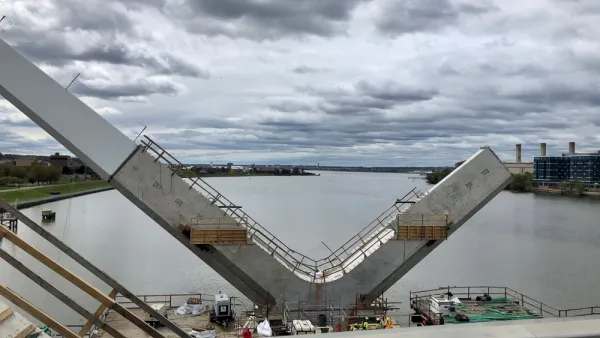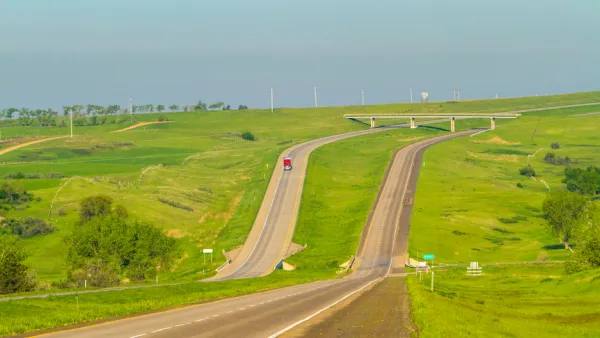When it comes to infrastructure, we are frequently reminded of the consequences of not repairing roads and bridges. Two prolific transportation writers recently changed the focus to where the money is spent.
Eric Jaffe of CityLab and Angie Schmitt of Streetsblog USA analyze Smart Growth America (SGA)'s "Repair Priorities 2014" report for their respective publications. The report itself is an update of SGA's 2011 report.
"The numbers tell the story best," writes Jaffe. "From 2004 to 2008, states dedicated just 43 percent of their road budgets to maintain existing roads despite the fact that they made up nearly 99 percent of the road system. The other 1 percent—new construction—got more than half the money."
From 2009 to 2011 states did only marginally better, spending 55 percent of their road money ($20.4 billion) on expansion and just 45 percent on maintenance ($16.5 billion).
However, sometimes new, costly construction over less expensive maintenance is justified, particularly when it comes to replacing structurally deficient bridges. Case in point, "the decaying Frederick Douglass Memorial Bridge, a mere 'dozen blocks from the dome of the U.S. Capitol'," as noted here recently. "[The occasional] falling concrete from the bridge poses a threat only to the fish in the Anacostia River below."
The bridge is also the first of "seven big infrastructure projects that are on the verge of collapse" described in the Vice Magazine article referenced Schmitt as an introduction to her insightful piece.
It's not as if the bridge hasn't been maintained. "In 2007, the bridge was closed from July 6 to August 29 for a $27 million renovation project meant to extend its life for 20 years," according to Wikipedia. Ashley Halsey III wrote in Dec. 2012 that it "needs to be replaced, at a cost of almost $661 million in a project with an overall price tag of $906 million." However, going from four to six lanes, as the plan notes, seems like it will only invite more driving as well as additional expense. But bike critics might say the same thing about the improvement to bike and pedestrian facilities.
Streetsblog USA's Angie Schmitt sees the problem of new construction vs. maintenance as symptomatic of a greater problem. "The system is set up to funnel the vast majority of spending through state departments of transportation, and those agencies have an absolutely terrible track record when it comes to making smart long-term decisions," she writes. "As long as state DOTs retain unfettered control of the money, potholed roads and decrepit bridges will remain the norm."
This is not a new theme for Schmitt. In 2011, she questioned the purpose of increasing Missouri's gas tax if it was only going to finance the I-70 expansion and other expensive, highway-widening projects, as we noted here.
FULL STORY: America's Infrastructure Crisis Is Really a Maintenance Crisis

National Parks Layoffs Will Cause Communities to Lose Billions
Thousands of essential park workers were laid off this week, just before the busy spring break season.

Retro-silient?: America’s First “Eco-burb,” The Woodlands Turns 50
A master-planned community north of Houston offers lessons on green infrastructure and resilient design, but falls short of its founder’s lofty affordability and walkability goals.

Delivering for America Plan Will Downgrade Mail Service in at Least 49.5 Percent of Zip Codes
Republican and Democrat lawmakers criticize the plan for its disproportionate negative impact on rural communities.

Test News Post 1
This is a summary

Test News Headline 46
Test for the image on the front page.

Balancing Bombs and Butterflies: How the National Guard Protects a Rare Species
The National Guard at Fort Indiantown Gap uses GIS technology and land management strategies to balance military training with conservation efforts, ensuring the survival of the rare eastern regal fritillary butterfly.
Urban Design for Planners 1: Software Tools
This six-course series explores essential urban design concepts using open source software and equips planners with the tools they need to participate fully in the urban design process.
Planning for Universal Design
Learn the tools for implementing Universal Design in planning regulations.
EMC Planning Group, Inc.
Planetizen
Planetizen
Mpact (formerly Rail~Volution)
Great Falls Development Authority, Inc.
HUDs Office of Policy Development and Research
NYU Wagner Graduate School of Public Service





























